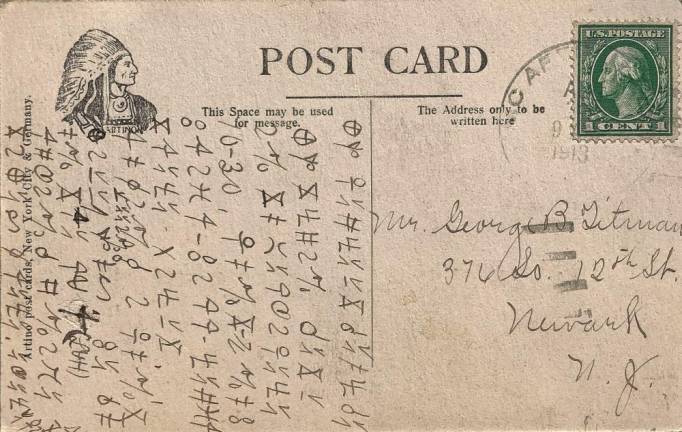Sussex County History Today: 1913 postcard in secret code
By Bill Truran

This column is by guest historian Ron Dupont.
I saw it while perusing eBay: An old McAfee postcard, with nice views of the limestone works and the lime quarry that were there.
A slightly uncommon card I did not already own. But what really grabbed me was on the back: The message. It was written in a secret code. I had to buy it.
In more than 40 years of research I had never seen a postcard in code. This fascinating document was postmarked Aug. 9, 1913, and addressed (in English, not code) to George B. Titman of 12th Street, Newark.
What was so secret, so special, that the sender had to write in secret code?
I guessed it was a substitution cipher, where letters of the alphabet are simply replaced with special characters. It’s not hard to crack such codes because the frequency of letters in the English alphabet is a known fact. It’s basic Boy Scout stuff.
But you need a decent amount of text, a few hundred words, to compare. This postcard had a mere 188 characters, with no breaks for words. Much tougher.
I fiddled with cracking it for a few days, researching old ciphers, copying out the characters, their frequency, and experimenting with various substitutions. My results produced exactly zip, zero, nada.
Given my penchant for self-torture, I would likely have puzzled over this thing for weeks, maybe months, metaphorically beating my head against the wall until I was half-nuts.
However, I had mentioned this puzzle to my son, Sam. He, being a practical, tech-oriented Gen-Zer, did something much more effective: He posted it on Reddit.
Specifically, he posted it on a forum dedicated to cracking codes and encryptions of all sorts, most far more complicated than mine. In a matter of mere hours, Reddit user “codewarrior0” solved it.
How? First, they figured it was a simple substitution code; then, by using intuition, guessing that the first line of a postcard of this era would contain a greeting. They guessed it would be “My Dear” or “My Dearest,” and they were right. From there, the rest of the code was deciphered easily.
So what does this ancient bit of cryptography conceal? What diabolical plans? What criminal enterprise? What illegal, immoral plottings?
The message turns out to be so kindly and simple, you first wonder why they bothered with code at all:
“My Dearest George - My train gets into Belvidere 10:30, don’t know which will reach there first. Hoping I don’t miss seeing you. We go on the L & H. Having a nice time up here. Ever, Edith.”
This explains it, I thought - a young couple traveling apart, by trains (one on the Lehigh & Hudson), in the summer, writing in code to each other. A sweet, romantic gesture between two folks courting and likely to be engaged.
And a little genealogical snooping reveals that, indeed, George Titman, 22, got married less than two years later - but not to Edith.
In 1915, George married Ethel Carlough. Was Edith another girl he was seeing? Was George two-timing Ethel? Playing the field?
Maybe Edith was just a friend or cousin, but clandestine romance sure would explain the secret code.
Whatever the case, George and Ethel had a long married life together, settling in Pompton Lakes, where he was a foreman at the DuPont (no relation, heh heh) Explosives Plant.
George died in 1962, Ethel in 1969. Who the mystery girl, Edith, was we will never know.
Her identity wasn’t the only secret that went to the grave with George.
How did George and Edith come up with the characters for their secret cipher? Some are common enough - percentage signs, hearts, crosshairs, Greek symbols, hashtags - and yet others are totally unique, nowhere to be found in any index of special symbols.
I can only guess these unknown symbols were entirely made up by George and Edith. It was their own personal secret code. Romantic indeed! Just don’t tell Ethel.
Bill Truran, Sussex County’s historian, may be contacted at billt1425@gmail.com